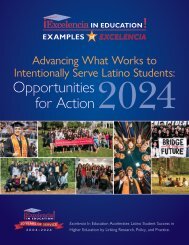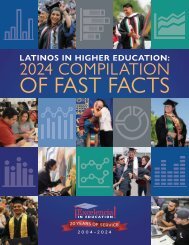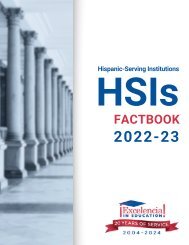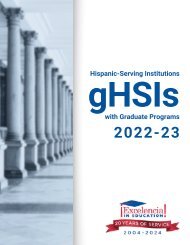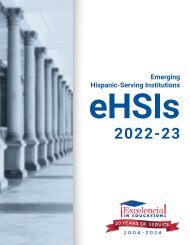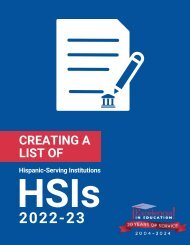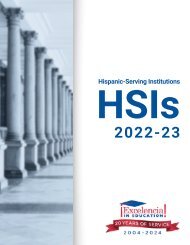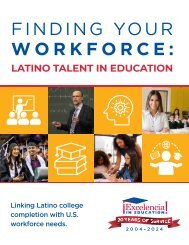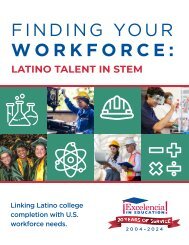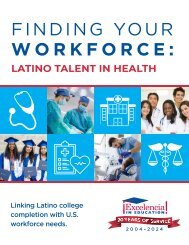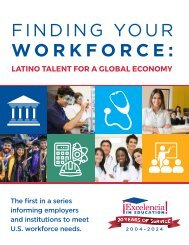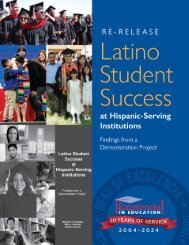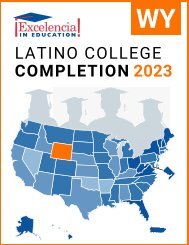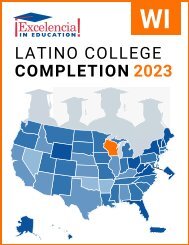Latino College Completion 2023: North Dakota
You also want an ePaper? Increase the reach of your titles
YUMPU automatically turns print PDFs into web optimized ePapers that Google loves.
ND
LATINO COLLEGE COMPLETION:<br />
NORTH DAKOTA – <strong>2023</strong><br />
For the U.S. to regain the top ranking in the world for college degree<br />
attainment, <strong>Latino</strong>s will need to earn 6.2 million degrees by 2030. 1<br />
FAST FACTS<br />
STATE RANKING:<br />
<strong>North</strong> <strong>Dakota</strong> had the 47th largest<br />
<strong>Latino</strong> population in the U.S.<br />
K-12 POPULATION:<br />
In <strong>North</strong> <strong>Dakota</strong>, 4% of the K-12<br />
population was <strong>Latino</strong>. 2<br />
POPULATION:<br />
In <strong>North</strong> <strong>Dakota</strong>, 4% of the<br />
population was <strong>Latino</strong>. 2<br />
MEDIAN AGE:<br />
The median age<br />
of Hispanics in<br />
<strong>North</strong> <strong>Dakota</strong> was<br />
24, compared<br />
to 38 for White<br />
non-Hispanics. 2<br />
24<br />
Hispanics<br />
38<br />
White<br />
non-Hispanics<br />
ENROLLMENT:<br />
In <strong>North</strong> <strong>Dakota</strong>, 20% of<br />
Hispanics (ages 18 to 34) were<br />
enrolled in higher education, compared<br />
to 27% of White non-Hispanics. 2<br />
DEGREE ATTAINMENT:<br />
In <strong>North</strong> <strong>Dakota</strong>, 27% of Hispanic<br />
adults (25 and older) had earned an<br />
associate degree or higher, compared to<br />
48% of White non-Hispanic adults. 2<br />
Hispanic Adults = 2.7 of 10<br />
To reach the degree attainment goal by 2030, the U.S. can: close<br />
the degree completion gap by accelerating <strong>Latino</strong> completion while<br />
increasing for all students and scale up programs and initiatives that<br />
work for <strong>Latino</strong>, and all, students. The following demographics,<br />
institutional data, and practices inform <strong>Latino</strong> degree attainment.<br />
ENROLLING: Top 5 Institutions (Hispanic Undergraduates) in <strong>North</strong> <strong>Dakota</strong>, 2021-22<br />
Institution<br />
Sector<br />
Grand Hispanic %<br />
Total Total Hispanic<br />
1 University of <strong>North</strong> <strong>Dakota</strong> Public, 4-year 8,998 462 5%<br />
<strong>North</strong> <strong>Dakota</strong> State University-Main<br />
2 Campus<br />
Public, 4-year 9,932 320 3%<br />
3 Minot State University Public, 4-year 2,248 191 8%<br />
4 Bismarck State <strong>College</strong> Public, 4-year 2,613 150 6%<br />
Private not-forprofit,<br />
4-year<br />
5 University of Jamestown<br />
992 99 10%<br />
ASSOCIATE DEGREES: Top 5 Institutions Awarding to Hispanics in <strong>North</strong> <strong>Dakota</strong>, 2020-21<br />
Institution<br />
Sector<br />
Grand Hispanic %<br />
Total Total Hispanic<br />
1 Bismarck State <strong>College</strong> Public, 4-year 704 27 4%<br />
2 Williston State <strong>College</strong> Public, 2-year 170 17 10%<br />
Private forprofit,<br />
4-year<br />
3 Rasmussen University-<strong>North</strong> <strong>Dakota</strong><br />
189 14 7%<br />
4 Lake Region State <strong>College</strong> Public, 2-year 197 13 7%<br />
5 <strong>North</strong> <strong>Dakota</strong> State <strong>College</strong> of Science Public, 2-year 454 9 2%<br />
BACHELOR DEGREES: Top 5 Institutions Awarding to Hispanics in <strong>North</strong> <strong>Dakota</strong>, 2020-21<br />
Institution<br />
Sector<br />
Grand Hispanic %<br />
Total Total Hispanic<br />
1 University of <strong>North</strong> <strong>Dakota</strong> Public, 4-year 1,878 73 4%<br />
<strong>North</strong> <strong>Dakota</strong> State University-Main<br />
2 Campus<br />
Public, 4-year 2,433 52 2%<br />
3 Minot State University Public, 4-year 504 34 7%<br />
Private not-forprofit,<br />
4-year<br />
4 University of Mary<br />
548 23 4%<br />
Private not-forprofit,<br />
4-year<br />
5 University of Jamestown<br />
142 13 9%<br />
NOTE: We use the terms <strong>Latino</strong> and Hispanic interchangeably in this factsheet.<br />
Source: Excelencia in Education analysis using U.S. Department of Education, National Center for<br />
Education Statistics (NCES), Integrated Postsecondary Education Data System (IPEDS), 2021 Fall<br />
Enrollment, Graduation Rates Survey and Institutional Characteristics Survey.<br />
White Adults = 4.8 of 10<br />
1 Projections to 2030: Excelencia in Education. (2020). Ensuring America’s Future: Benchmarking <strong>Latino</strong><br />
<strong>College</strong> <strong>Completion</strong> to 2030. Excelencia in Education. Washington, D.C.<br />
2 U.S. Census Bureau, 2021 American Community Survey 1-Year Estimates
<strong>North</strong> <strong>Dakota</strong> Gap in Degree <strong>Completion</strong><br />
Closing the degree completion gap can be tracked<br />
by the 4 measures shown below. Alone, none<br />
of these measures capture the entire “story” of<br />
degree completion. However, in combination,<br />
they provide a useful picture of the gap in degree<br />
attainment between Hispanic and White non-<br />
Hispanic cohorts in a single year.<br />
Graduation Rate — Total percentage of students<br />
who graduated within 150% of normal time for<br />
first-time, full-time freshmen. This incorporates<br />
students that graduated in 3 years at two-year<br />
institutions, or in 6 years at four-year institutions.<br />
Transferred to Another Institution —<br />
Percentage of students that transferred to another<br />
institution and did not complete a degree.<br />
Still Enrolled — Percentage of students that are<br />
still enrolled at the point of 150% normal time to<br />
completion.<br />
No Longer Enrolled — Percentage of students<br />
that are no longer enrolled at the point of 150%<br />
normal time to completion.<br />
At two-year institutions, Hispanics’<br />
graduation rate was 14%-points<br />
lower than that of their White non-<br />
Hispanic peers in <strong>North</strong> <strong>Dakota</strong>.<br />
TWO-YEAR INSTITUTIONS<br />
45%<br />
4%<br />
7%<br />
44%<br />
WHITE<br />
1%<br />
-14%<br />
61%<br />
8%<br />
30%<br />
HISPANIC<br />
DEGREE OUTCOMES<br />
■ No Longer Enrolled<br />
■ Still Enrolled<br />
■ Transferred to<br />
Another Institution<br />
■ Graduation Rate<br />
*Percentages may not add up to 100% due to rounding.<br />
At four-year institutions, Hispanics’<br />
graduation rate was 17%-points<br />
lower than that of their White<br />
non-Hispanic peers in <strong>North</strong><br />
<strong>Dakota</strong>.<br />
FOUR-YEAR INSTITUTIONS<br />
3%<br />
15%<br />
62%<br />
WHITE<br />
-17%<br />
26%<br />
45%<br />
HISPANIC<br />
NOTE: Outcomes shown are for students at two-year institutions who started in Fall 2018, and<br />
for students at four-year institutions who started in Fall 2015.<br />
Source: Excelencia in Education analysis using the U.S. Department of Education, National<br />
Center for Education Statistics (NCES), Integrated Postsecondary Education Data System, 2021<br />
Graduation Rates Survey and the Institutional Characteristics Survey.<br />
21%<br />
4%<br />
24%<br />
Examples of What Works for <strong>Latino</strong> Students<br />
There are institutions showing success in enrolling, retaining, and graduating <strong>Latino</strong> students. The following are examples of<br />
programs across the country with evidence of effectiveness in serving <strong>Latino</strong> students nominated for Examples of Excelencia.<br />
The Pathways to Academic Success and Opportunities (PASO)<br />
at California State University-San Marcos (CSUSM) aims to expand<br />
educational opportunities and improve the academic attainment of <strong>Latino</strong><br />
students. With a focus on retention and graduation of <strong>Latino</strong> students,<br />
they address the achievement gap among <strong>Latino</strong> students by implementing<br />
innovative student services, culturally-relevant curriculum, and meaningful<br />
co-curricular offerings aimed at increasing retention and graduation rates<br />
specifically for <strong>Latino</strong> students. Strong collaborative efforts with Student and<br />
Academic Affairs are infused into their Title V grant. PASO Scholars have<br />
demonstrated higher pass rates than the overall California State University<br />
San Marcos population and greater cultural connection with PASO classes.<br />
New efforts to reach students within Student Affairs, has yielded long term<br />
changes to the financial aid process, outreach, admissions, and CSUSM<br />
advising. Student Orientations for PASO parents and students are essential<br />
to assist with the high school to college transition. PASO has its own fulltime<br />
Financial Aid technician, which has increased awarded <strong>Latino</strong> students.<br />
Upper-division students work as PASO community researchers with the<br />
CSUSM-National <strong>Latino</strong> Research Center gaining experience in the field.<br />
PASO offers a pilot Chicano Studies course that has now catapulted the<br />
request for a Chicano Studies major at CSUSM.<br />
PASO has helped increase overall <strong>Latino</strong> enrollment from 29% in Fall<br />
2017 to 45% in Fall 2018 and <strong>Latino</strong> retention from 70% to 78% in the<br />
same timeframe. All students in PASO courses are <strong>Latino</strong> first-year<br />
students, demonstrating a higher pass rate than students taking non-PASO<br />
courses. The pass rates for PASO courses range from 85% to 100% and<br />
average a 10% higher pass rate than other equivalent CSUSM courses.<br />
Increased financial aid application completion by <strong>Latino</strong>s and <strong>Latino</strong>s<br />
awarded financial aid: 421 of 509 PASO Scholars (83%) were selected<br />
for financial aid verification. Over 90% of PASO students completed the<br />
verification process. Overall, 88% of all PASO Scholars were awarded<br />
financial aid, a 30% improvement in <strong>Latino</strong> students awarded financial aid.<br />
For more information on institutional programs improving <strong>Latino</strong> student success in higher education, access Excelencia in<br />
Education’s Growing What Works database at http://www.edexcelencia.org/growing-what-works<br />
ENSURING AMERICA’S FUTURE BY INCREASING LATINO COLLEGE COMPLETION • WWW.EDEXCELENCIA.ORG




